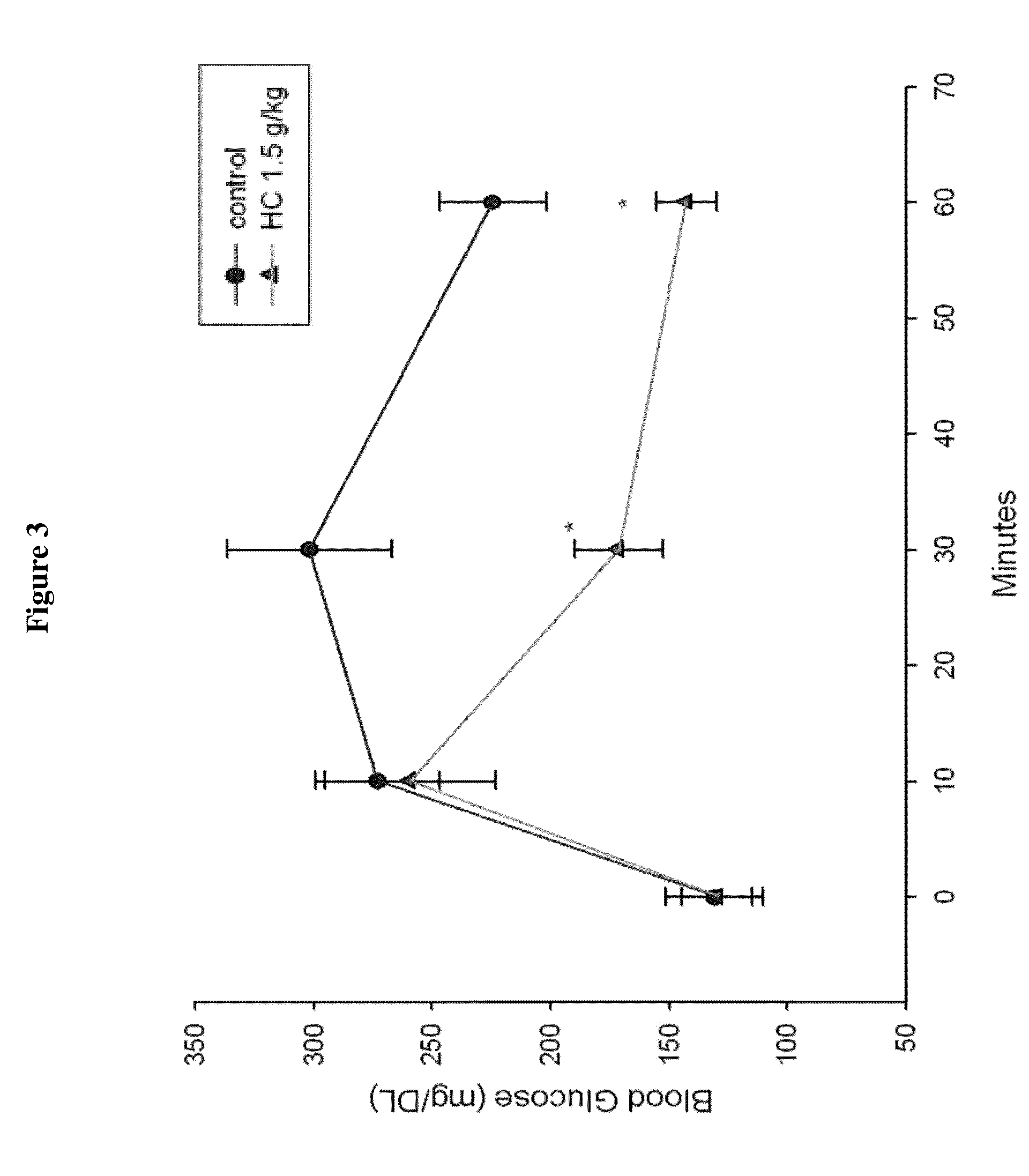Plant extract for treating diabetes and process for making same
- Summary
- Abstract
- Description
- Claims
- Application Information
AI Technical Summary
Benefits of technology
Problems solved by technology
Method used
Image
Examples
example 1
Glucose Tolerance Test of Ethanol Extract of Leaves and Pseudostems of Hedychium coronarium Koening in Normal Rats
[0102]Twenty-six (26) Sprague-Dawley rats were divided into four groups: the placebo group (7 rats, to be administered with 10% Tween 20), the positive control group (7 rats, to be administered with glibenclamide), the 250 mg / kg HC group (6 rats, to be administered with 250 mg / kg ethanol extract of leaves and pseudostems of Hedychium coronarium Koening), and the 750 mg / kg HC group (6 rats, to be administered with 750 mg / kg ethanol extract of the leaves and pseudostems of Hedychium coronarium Koening). The rats were fasted for 7 hours and then administered with 250 mg / kg ethanol extract of leaves and pseudostems of Hedychium coronarium Koening (the 250 mg / kg HC group), 750 mg / kg ethanol extract of leaves and pseudostems of Hedychium coronarium Koening (the 750 mg / kg HC group), 10 mg / kg glibenclamide (the positive control group), or 10% Tween 20 (the placebo / control group)...
example 2
Glucose Tolerance Test of Ethanol Extract of Leaves and Pseudostems of Hedychium coronarium Koening in Mice with Type II Diabetes (Short-Term Postprandial Blood Glucose)
[0104]Twelve (12) mice with type II diabetes (db+ / db+ mice) were fasted for 12 hours and then allowed to feed freely for two hours. Subsequently, 6 mice of the control group were orally administered with 10% Tween 20, and 6 mice of the 1.5 g / kg HC group were orally administered with 1.5 g / kg ethanol extract of leaves and pseudostems of Hedychium coronarium Koening. Blood was drawn from each animal at intervals of 0, 10, 30 and 60 minutes after administration for measurement of glucose (mg / DL). The results are shown in the table below and FIG. 2.
Concentration of blood glucose (mg / DL)Group0 min10 min30 min60 minControl group; N = 6397.0 ± 12.6652.2 ± 25.5 645 ± 29.8536.3 ± 40.3HC group; N = 6396.8 ± 15.1534.3 ± 47.0440.2 ± 37.2**406.5 ± 38.8*The data is expressed with mean + / − standard error (SEM). P values are calcul...
example 3
Intraperitoneal Glucose Tolerance Test of Ethanol Extract of Leaves and Pseudostems of Hedychium coronarium Koening in Normal Mice
[0106]Eight (8) mice (db− / db− mice) were divided into two groups: the control group (4 mice, to be administered with 10% Tween 20) and the 1.5 g / kg HC group (4 mice, to be administered with 1.5 g / kg ethanol extract of leaves and pseudostems of Hedychium coronarium Koening). The mice were fasted for 14 hours and then allowed to feed freely for two hours. Subsequently, these animals were orally administered with 10% Tween 20 (the control group) or 1.5 g / kg ethanol extract of leaves and pseudostems of Hedychium coronarium Koening (the 1.5 g / kg HC group). After 30 minutes, each mouse was intraperitoneally administered with 1.5 g / kg glucose. Blood was drawn from each animal at intervals of 0 minutes, 10 minutes, 30 minutes and 60 minutes for the measurement of glucose (mg / DL). The results are shown in the table below and FIG. 3.
Concentration of blood glucose (...
PUM
 Login to View More
Login to View More Abstract
Description
Claims
Application Information
 Login to View More
Login to View More - R&D
- Intellectual Property
- Life Sciences
- Materials
- Tech Scout
- Unparalleled Data Quality
- Higher Quality Content
- 60% Fewer Hallucinations
Browse by: Latest US Patents, China's latest patents, Technical Efficacy Thesaurus, Application Domain, Technology Topic, Popular Technical Reports.
© 2025 PatSnap. All rights reserved.Legal|Privacy policy|Modern Slavery Act Transparency Statement|Sitemap|About US| Contact US: help@patsnap.com



